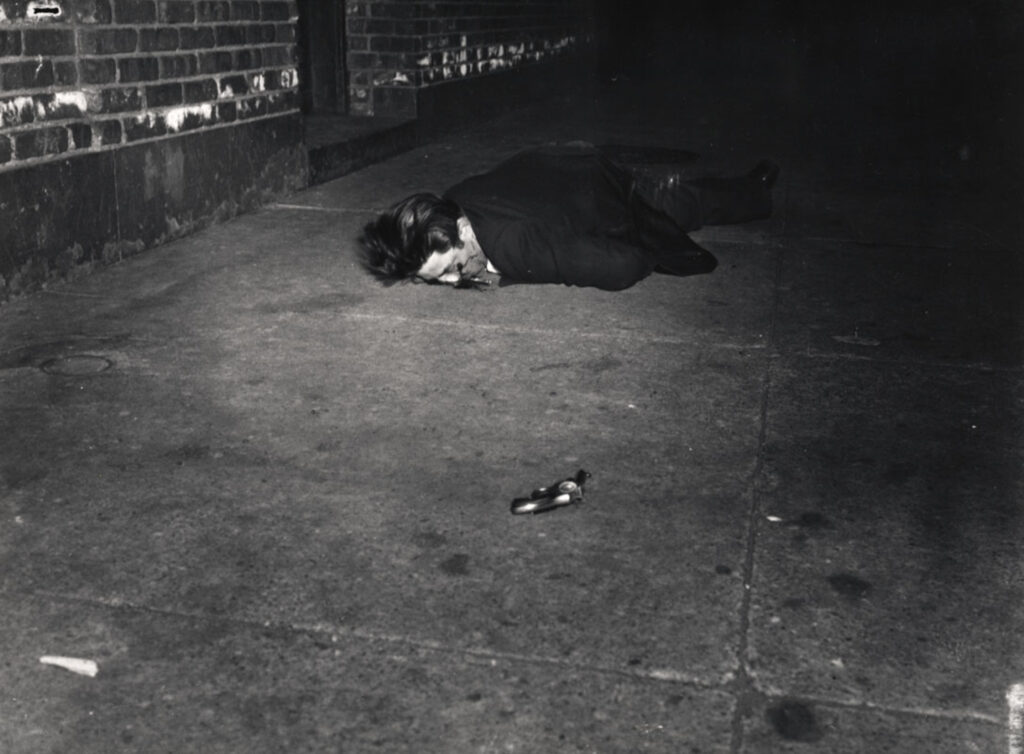There Was More to Weegee Than Lurid Shots of Dead Gangsters
If a murdered mobster was slumped and bleeding over his linguine, the pioneering crime scene photographer was there minutes later, camera in hand.

‘Weegee: Society of the Spectacle’
International Center for Photography, 84 Ludlow Street, New York, NY
Through May 5, 2025
The groundbreaking street photographer of the 1930s and 1940s, Arthur Fellig, also known as Weegee, is best known for his lurid shots of dead gangsters and madding crowds. A new retrospective at the international Center for Photography, though, features more varied facets of the man generally revered as the first crime photographer.
His first book “Naked City,” published in 1945, made him an instant celebrity with his all-hours portraits of New York, where he roamed from 3 am coffee shops to debutante balls, from dance halls to dive bars, all in search of unique and arresting images of the sleepless city.
Using his relationship to social “spectacle” as a starting point, the current show branches away from his most famous snaps to other works he did in portraiture, showbusiness, even caricature. Weegee was broader than we knew, in other words.
That being said, Weegee’s stock in trade has always been his sharp and fearless eye, his ability to root out the hidden, the tragic, and the lurid. A Weegee shot is a gut punch delivered with unforgiving rawness. If a murdered mobster was slumped and bleeding over his linguine, Weegee was there minutes later, camera in hand. His ability to be on the scene was so supernatural, people began to believe he was a living breathing Ouija board, resulting in his phonetic nickname. He also had an instinct for dramatic framing that far surpassed his peers.
Take his photography of Anthony Izzo, lying on the sidewalk after being shot by an off-duty police officer. Taken after a Broome Street stick up gone awry, Izzo lies face down after a bullet to the face. You’d think a close up might be in order, but instead Weegee is careful to foreground the shot with a broad stretch of concrete and the dull glint of the gun that shot him, leading the eye to the crumpled figure.

Yet most important is the way the face, with its single bullet hole leaking blood, is in a pool of burnished light. The rest of his body, trailing off to the far corner, is swallowed in blackness. In the developing process Weegee no doubt sharpened the contrast in such a dramatic way that recalls Manet’s dead matador. It’s grim, it’s stark, it’s unforgettable.
Weegee was also one of the first photographers to snap bystanders in the act of witnessing horrific events. He knew that witnesses were as much a part of the story as the main players. Hence one of his most famous photographs, also featured here, of Brooklyn schoolchildren witnessing the murder of a gambler in the street.
A tow-headed boy of about 11 is grinning maniacally at the scene, an unfortunate reminder that for many violence is entertainment. Another girl cranes her head over with morbid curiosity, straining to see. Only an older woman is properly affected by the tragedy, her face in a rictus of horror. Weegee manages to capture a complex portrait of violence and its discontents in a single frame.
Steering away from Weegee’s grim snaps of tragedy, there are also prints that show us a varied and multi-faceted New York that is always surprising. A young man dressed as a woman, beaming and showing us some leg as they are led into a paddy wagon.
There is an affecting portrait of a young muscular dwarf in clown make up, backstage at the circus. There are astonishing prints of a woman being shot from a cannon. These images show us that laws and customs may have changed, but New York has always been a novelty generator.
Opting for a meta-approach, the show’s curators make a hard sell of the idea of Weegee as a lover of spectacle. They even mention “The Society of the Spectacle,” a radical tract by Guy Debord at the show’s opening. It’s hard to know what the abstruse manifesto of a French Marxist could say about a career like Weegee’s, however.
His is a deeply idiosyncratic and American story, a New York story nearly resistant to intellectual analysis. Fellig pops up like a mythical character from a Herbert Gold novel: if he hadn’t been born, he would have to be invented. The son of Ukrainian immigrants, he grew up roaming the Lower East Side, just as the Jewish and Italian mob were ascendant. New York was alive with drama, eccentricity and tragedy. Fellig picked up a camera at one point and got hooked.
A tireless dynamo — “I’m a doer not a thinker” he once said — Fellig single-handedly invented the job of “freelance photographer” by hanging around police stations and keeping an ear out for teletype announcements. It wasn’t only luck, however. He was good with people, and he unfailingly earned the trust of both subjects and law enforcement. By 1948, he was the only photographer in the Five Boroughs that had his very own radio, tuned to NYPD’s private police band.
The show also does a good job of cutting through Weegee’s cultivated mystique, showing us the man behind the lens. There is a rare photo of him in his New York apartment, collapsed on a futon in a corner. You can see the obvious toll his relentless image hunting must have taken on him.
The wall behind him is an unkempt forest of clippings, leads and prints. His desk is cluttered with cameras, lenses, flashes, papers, and recording devices. It’s one of the earliest known snapshots of what we would now call a photojournalist: those harried creatures of irregular hours, questionable morals, and obsessive habits who must be up at a moment’s notice to snap at their quarry.
Weegee was the perfect combination of gumption, energy, and style, allowing us a unique glimpse into one of the most storied eras of New York history. He may have spawned the questionable figure of the paparazzo, but he was an artist first and foremost. This show establishes him as the original, if not the greatest, master of the genre.

